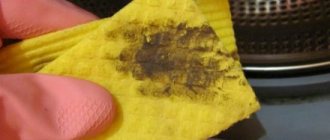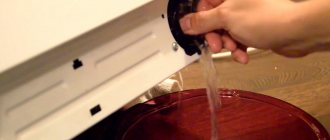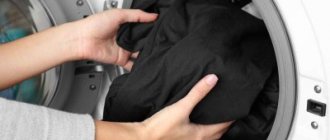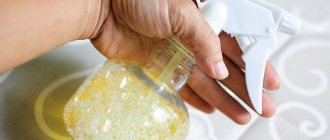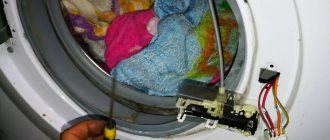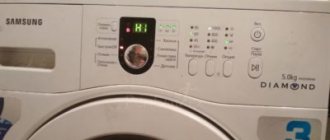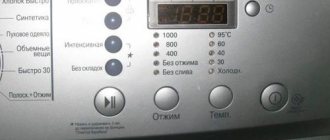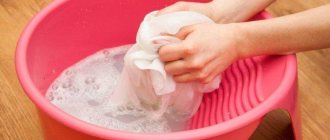When the automatic machine is not to blame
In some cases, the appearance of stains is not due to a breakdown of the machine, but to the owner’s carelessness during operation. Also, the cause of the problem is often neglect of the instructions for use.
Colored and light things at the same time
Washing colored and light-colored items at the same time results in pigmentation appearing on the clothing. As a rule, fabrics dyed in bright colors fade heavily at high water temperatures. To avoid this problem, it is necessary to wash these types of items separately.
Rusty water in the water supply
If the water becomes rusty due to problems with the plumbing, then red and brown stains appear on light-colored products. Rust occurs in old pipes or as a result of repairs to mains. Before starting the machine, you should drain the rusty water.
Powder with color corrector
The color corrector in washing powder is designed to hide yellowness. In cases where there is no yellowness on things, an optical or chemical corrector gives the clothes a purple tint. Most often this happens when washing at low temperatures, when the granules do not dissolve enough.
See also
TOP 13 methods on how to effectively remove sand from clothes at home
Overdose of washing powder
The amount of powder is determined depending on the weight and dirtiness of the clothes loaded into the drum. If you pour in an excess amount of powder, it will not completely dissolve and will leave pronounced stains on the fabric, which is most noticeable on dark and denim fabrics.
Traces of grease on clothes
The ingress of fatty oils during cooking or applying cosmetics leaves barely noticeable stains, which become larger and brighter during washing. Fat appears from interaction with hot water, resulting in the formation of yellow marks. Before loading things into the drum, you need to remove the fat by sprinkling salt on it.
Wrong choice of detergent
Standard powders and detergents are not suitable for delicate silk and wool fabrics, outerwear with various fillings. The powder dissolves poorly, leaving white streaks. An additional problem is that delicate fabrics can shrink after washing if the wrong product is used.
Drum seal leaking
During the operation of washing machines, a situation often arises when, instead of a high-quality wash, new stains and smudges appear on things. It is important to know what to do if your washing machine stains your clothes. First of all, you need to carefully inspect the device for leaks. It is important where exactly the water is leaking from.
If, while the washing machine is operating, a water leak is noticed from below, from the side where the bearings are located, then most likely the drum seal has failed. A worn out oil seal must be replaced. Most often, this problem occurs during spinning.
If the oil seal leaks, you should immediately stop working the machine, because due to wear of the oil seal, water gets onto the bearings and they rust. At the same time, both they themselves deteriorate and can stain the laundry in the drum.
To replace a damaged oil seal, you will also have to change the bearings. This is not an easy procedure and if you do not have the skills, it is better to contact a specialist. If you decide to repair the machine yourself, then you need, first of all, to buy two bearings and an oil seal.
To guarantee success, it is recommended to remove the old ones from the car and buy the same ones by numbers, or analogues. Another option is to contact a washing machine spare parts store, where specialists will select everything you need based on the make and model of the machine.
To replace the oil seal, do the following:
- Remove the top panel;
- Remove the bottom cover;
- Remove the front panel;
- Carefully remove the rubber sealing collar;
After completing the manipulations, you should disassemble the tank of the machine to get to the bearings. The tank is separated into two halves, secured with special latches along its perimeter.
By disconnecting the latches or unscrewing the bolts (if the model has bolts instead of latches), the front half of the drum should come out freely. Taking this opportunity, it is recommended to clean it of dirt and debris.
To remove the rear half of the tank, you will need to remove the pulley, which is held on by one bolt. Having unscrewed it, the pulley must be removed and the bolt screwed back into the drum shaft. Now the drum can be carefully knocked out by hitting the shaft with a hammer.
When the shaft reaches the surface of the bolt head, the bolt must be unscrewed and the back of the drum removed. A preventive inspection of the bushing and the shaft itself will prevent costly repairs if they are worn out.
New bearings should be placed on the shaft and checked for play. If there is any play, the shaft and crosspiece will have to be replaced.
Bearings can only be replaced after removing the oil seal. To pull it out from the back of the car, you will need a flat-head screwdriver to pry it up and remove it. To replace the bearings you will need to knock them out. Moreover, the small one is knocked out from the inside, and the big one from the outside.
Important: the washing tub is quite fragile, so you should be careful when knocking out the bearings so as not to damage it. New bearings are driven into their places that have been previously cleaned to a shine. The purchased oil seal must be “filled” with oil (necessarily waterproof) and inserted into place.
If you don’t have a special lubricant at hand, you can also apply Litol-24 by purchasing it at a car parts store. The machine is assembled in reverse order. It is recommended to take photographs during disassembly so as not to accidentally mix up the parts during reassembly.
Why does it get dirty when washing?
The appearance of dark spots on clothes after washing can occur due to infrequent or improper care of the equipment. As a result of this, the following are formed:
- deposits in the pump cleaning mechanism;
- dirt and mold in the cuff;
- Mold in the detergent compartment.
Dirty cuff
Dirty water regularly penetrates the fold of the rubber cuff, which over time produces an unpleasant odor and causes dark stains to form on things.
If you do not periodically clean the cuff and leave the door for ventilation, plaque will form on the parts and mold will grow.
Mold in the tray
The powder tray constantly interacts with the liquid as the water washes away the added detergent. Lack of maintenance of the compartment causes mold and dirt, which penetrate into the drum during washing. The result is the appearance of black spots and the impregnation of clothing with a pungent odor.
Contaminants in the drain system
The tube connected to the tank and the recirculation pump become clogged when the machine is used for a long time. If pronounced gray spots appear on clothing, you need to take measures to care for the equipment so that dirt does not get into the drum along with the water.
See also
How to properly wash thermal underwear, methods for cleaning things and what not to do
Problems with operation
Malfunctions of the internal components of the washing machine and malfunctions in the operating mode disrupt the washing process. As a result, stains, dark stripes and other defects appear on clothes.
Problems with the seal
The oil seal acts as a gasket between the drum and the bearing, providing protection against water penetration. For sliding, the oil seal is treated with lubricant. When a part wears out, the liquid washes away the lubricant, it gets into the drum and leaves brown stains on things, oily in structure.
Foreign objects in the tank
Before each wash, you should always check your clothing pockets. Penetrating into the drum, foreign objects settle at the bottom of the tank, rust over time and pollute the water. Because of this, rusty and dark yellow stains appear on clothes, which are difficult to remove without leaving a trace.
Washing clothes with rust in a washing machine
Using an automatic machine will make the process of removing rust from things much easier for the housewife and will seriously improve the results.
First you need to remove excess dirt from the fabric with a soft-bristled brush, then rinse under cold water. Afterwards, you can put the item to soak or turn on a mode that already provides such a function (for example, with pre-wash). Then wash the product with powder or stain remover. Usually the result is pleasing: the clothes return to their original appearance.
It is better to try not to get rust stains so that the item serves faithfully without much hassle and effort.
How to remove stains correctly
In most situations, stains on clothing can be removed by repeated washing. If this does not help, you can resort to the following methods:
- Treat stains with a special stain remover. The substances are applied to dirty areas, rubbed in, and then washed off with water.
- Wash items with a mixture of glycerin and dishwashing detergent. This option is suitable for T-shirts and other white items.
- Dissolve 3 tablespoons of wine vinegar in a glass of water, soak the clothes for a couple of hours and perform a basic wash. This method is effective in removing stains from jeans.
- Soak the contaminated area in citric acid or lemon juice for 15 minutes, then rinse the substance with warm water and rinse the product in a soapy solution.
Signs of low-quality washing powder
Using low-quality detergent for washing is a common cause of stains and dirt on clothes. When choosing a washing powder, many take into account only the type of washing machine, without paying attention to other criteria. It is often possible to notice the low quality of the powder only during washing based on a number of signs.
See also
Step-by-step instructions on how to properly assemble a child car seat after washing
Does not dissolve in water
Powder granules should dissolve during washing, regardless of the water temperature. If the quality of the product is poor, the granules do not dissolve enough in cold or warm water and leave stains on clothes.
Gives foam
The formation of foam during washing indicates good dissolution of the powder. If the powder creates a minimal amount of foam, this may affect the wash result.
It is also important to know that a number of modern detergents have reduced foaming, so in this situation the amount of foam is not related to the quality of the powder.
As a rule, high-quality and more expensive washing powders foam well and effectively remove dirt from fabric surfaces of any type. Modern manufacturers of detergents often add conditioner to the powder, which creates a double effect from washing things. As a result, clothes do not require additional processing and become clean and pleasant to the touch.
Smell
High-quality washing powder has a neutral, faint odor. The presence of an unpleasant odor occurs after the expiration date, when storage conditions are violated and mold forms. If immediately after opening the package or over time the washing powder acquires an unnatural odor, it is recommended to refrain from using it and purchase a new detergent.
Dirty cuff, filter or tray
The rubber sealing cuff can be effectively cleaned from mold using copper sulfate. To do this, dissolve the substance in water in a proportion of 30 grams per liter of water, and apply the resulting solution to and under the elastic band. After a day, the solution should be washed off and wiped dry with a clean cloth. To completely wash out the substance, it is recommended to run the car in the “Fast 30” mode.
If a large amount of debris is found under the rubber seal or gray or black spots of mold appear, then to clean it you will have to completely remove the cuff and then wash it in a basin or pan. If damage is found on the surface of the rubber band, it must be replaced.
First of all, dirt and debris accumulate in the drain system, or more precisely in the garbage filter and the pipes adjacent to it. They are installed for this purpose, but their performance depends on systematic care and cleaning.
The filter is most often located on the right side of the washing machine, at the bottom and is closed with a sealed decorative cover, which can be opened by applying a certain amount of force using a flat-head screwdriver. In some models, the lid is held in place by special latches or rotary hooks, for example, on machines from the Bosch and Samsung brands.
The filter itself is unscrewed counterclockwise and washed. In a situation where the drain system is too dirty and it is not possible to dismantle the filter, you should remove one of the walls of the unit and clean the system from the pump side. After cleaning the filter, you should check and, if necessary, clean the hole in which it is installed. Dirt and debris accumulate there over time.
After cleaning the machine, it must be checked for correct assembly. To do this, the unit must be turned on and started in the “Drain” mode. If you can hear the pump blades and impeller spinning and no water leakage is noticed, then everything is in order.
If the laundry detergent container becomes dirty, wash it in hot water and soap, removing dirt and residue from hard-to-reach places using a small brush. It is convenient to use an unnecessary toothbrush.
If the plaque layer is large or mold has appeared, it is recommended to use cleaning products containing chlorine. For example, products to combat plaque and dirt in the toilet. It needs to be poured into a tray and after an hour and a half, thoroughly cleaned and rinsed in warm water.
When to contact a specialist
Most of the causes of stains on clothes after washing can be eliminated independently, without contacting a service center. You should seek help from specialists in cases where it is not possible to diagnose the exact cause of the problem or when serious equipment breakdowns occur. Timely diagnosis and repair of internal mechanisms allows not only to solve the problem of poor-quality washing of clothes, but also helps to extend the service life of the machine.
The “culprits” for the appearance of stains on clothes
Repairers of washing units note that there are more than a dozen reasons why a machine can dirty things. They are all divided into:
Simple factors for the appearance of pollution
Eliminating the above reasons that lead to flaws is as easy as shelling pears. Enough:
Other factors causing stains
Have you checked everything, but haven’t found the reasons described above why things get dirty due to the fault of the machine? Most likely, we are talking about problems of a more serious nature:
